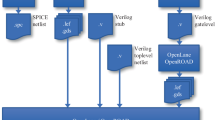Abstract
This paper expounds a complexity-reduced Volterra series model for radio frequency power amplifier (PA) behavioral modeling and digital predistortion (DPD). An analysis was conducted, which took into account the memory effect mechanisms of the PA. This led to a closed-form expression that relates the memoryless behavior of the PA to the finite impulse response feedback filter, which approximates the memory effects’ behavior. The analysis resulted in a complexity-reduced Volterra series model which allows for a substantial reduction in the requirements for digital signal processors and the time needed to construct and implement the DPD in a real-time environment. The proposed model was validated as a behavioral model and a DPD using two different PA architectures, employing two different transistor technologies, driven by both 20 MHz 1001 wideband code division multiple access and long term evolution signals. The results obtained demonstrate the excellent modeling and linearization capability of the complexity-reduced Volterra series model.









Similar content being viewed by others
References
Wright, P., Lees, J., Tasker, P., Benedikt, J., & Cripps, S. C. (2009). An efficient, linear, broadband class-J-mode PA realised using RF waveform engineering. In IEEE MTT-S international microwave symposium digest (pp. 1721–1724).
Jiang, H., & Wilford, P. A. (2010). Digital predistortion for power amplifiers using separable functions. IEEE Transactions on Microwave Theory and Techniques, 58, 4121–4130.
Isaksson, M., Wisell, D., & Ronnow, D. (2006). A comparative analysis of behavioral models for RF power amplifiers. IEEE Transactions on Microwave Theory and Techniques, 53, 348–359.
Tehrani, A. S., Cao, H., Afsardoost, S., Eriksson, T., Isaksson, M., & Fager, C. (2010). A comparative analysis of the complexity/accuracy tradeoff in power amplifier behavioral models. IEEE Transactions on Microwave Theory and Techniques, 58(6), 1510–1520.
Zhu, A., Pedro, J. C., & Brazil, T. J. (2006). Dynamic deviation reduction-based Volterra behavioral modeling of RF power amplifiers. IEEE Transactions on Microwave Theory and Techniques, 54(12), 4323–4332.
Staudinger, J., Nanan, J. C., & Wood, J. (2010). Memory fading Volterra series model for high power infrastructure amplifiers. In IEEE radio and wireless symposium, 2010.
Zhu, A., Pedro, J. C., & Cunha, T. R. (2007). Pruning the Volterra series for behavioral modeling of power amplifiers using physical knowledge. IEEE Transactions on Microwave Theory and Techniques, 55(5), 813–821.
Zhu, A. & Pedro, J. C. (2007). Distortion evaluation of RF power amplifiers using dynamic deviation reduction based Volterra series. In IEEE MTT-S international microwave symposium digest, Honolulu, HI (pp. 965–968).
Liszewski, J., Schubert, B., Keusgen, W., & Kortke, A. (2011). Low-complexity FPGA implementation of Volterra predistorters for power amplifiers. In IEEE topical conference on power amplifiers for wireless and radio applications (pp. 41–44).
Guan, L. & Zhu, A. (2011). Simplified dynamic deviation reduction-based Volterra model for Doherty power amplifiers. In Workshop on integrated nonlinear microwave and millimetre-wave circuits (INMMIC) (pp. 1–4).
Cunha, T. R., Pedro, J. C., & Lima, E. G. (2008). Low-pass equivalent feedback topology for power amplifier modeling. In IEEE MTT-S international microwave symposium digest.
Maziere, C., Soury, A., Ngoya, E., & Nebus, J. M. (2005). A system level model of solid state amplifiers with memory based on a nonlinear feedback loop principle. In 2005 European microwave conference (Vol. 1, pp. 4–6).
Morgan, D. R., Ma, Z., Kim, J., Zierdt, M. G., & Pastalan, J. (2006). A generalized memory polynomial model for digital predistortion of RF power amplifiers. IEEE Transactions on Microwave Theory and Techniques, 54(10), 3852–3860.
Wu, D. Y. T., Mkadem, F., & Boumaiza, S. (2010). Design of a broadband and highly efficient 45 W GaN power amplifier via simplified real frequency technique. In IEEE MTT-S international microwave symposium digest, Anaheim, CA.
Wu, D. Y. T. (2003). A Doherty power amplifier with extended bandwidth and reconfigurable back-off Level. PhD Dissertation, University of Waterloo.
Messaoudi, N., Fares, M.-C., Boumaiza, S., & Wood, J. (2008). Complexity reduced odd order only memory polynomial predistorter for multicarrier Doherty power amplifier linearization. In IMS 2008.
Acknowledgments
This work was supported by the University of Waterloo, Waterloo, ON, Canada, and the Natural Sciences and Engineering Research Council of Canada (NSERC). The authors would like also to acknowledge the support of Agilent Technologies, for their donation of Advanced Design System software, and Freescale Semiconductor, for their donation of power amplifiers.
Author information
Authors and Affiliations
Corresponding author
Appendix
Appendix
Rights and permissions
About this article
Cite this article
Mkadem, F., Fares, M.C., Boumaiza, S. et al. Complexity-reduced Volterra series model for power amplifier digital predistortion. Analog Integr Circ Sig Process 79, 331–343 (2014). https://doi.org/10.1007/s10470-014-0266-4
Received:
Revised:
Accepted:
Published:
Issue Date:
DOI: https://doi.org/10.1007/s10470-014-0266-4




